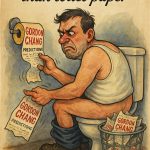Nov 13, 2023
The War on Cash Central Banks Doubling Down
“We’ll delve into this from historical and current angles. Learning from history prevents repetition. Despite rising rates, the war on cash persists. Banks exploit individuals by manipulating rates, impacting both savers and non-savers. Costs rise, while salaries often lag behind increasing rates.”
In the realm of global finance, the landscape is continuously evolving, with central banks taking unprecedented measures to navigate economic challenges. One such measure that has gained traction over the past decade is the implementation of negative interest rate policies (NIRP). As of 2022, more than 20 central banks worldwide have embraced this unconventional strategy, a significant increase from the 14 that adopted it in 2019. Notable institutions, including the European Central Bank, Swiss National Bank, Bank of Japan, and Sweden’s Riksbank, have all ventured into the uncharted territory of negative interest rates.
Historically, economists viewed negative interest rates with skepticism, warning that such a financial experiment could have disastrous consequences. However, as the global economy faced persistent challenges, negative rates emerged as a seemingly necessary prescription to stimulate growth. The notion of charging depositors for the privilege of keeping money in banks was once considered absurd; today, it is portrayed as a crucial tool in rescuing struggling economies.
The pressure on central banks to adopt negative interest rates has intensified, with the US Federal Reserve facing mounting calls to abandon its longstanding positive rate stance and join the global negative rate club. The rationale behind such a shift is rooted in the belief that negative rates incentivize spending over saving. By essentially penalizing individuals for holding onto cash, central banks hope to spur consumer spending, investment, and ultimately economic growth.
The persistent war on cash is a key component of this strategy. While interest rates have been on the rise in various economies, central banks are doubling down on efforts to reduce the use of physical currency. This trend is not merely a response to prevailing economic conditions; it is a deliberate strategy to exert control over monetary transactions and reshape financial behaviors.
Banks, in their pursuit of monetary policy objectives, have taken advantage of the prevailing economic climate to manipulate interest rates. This manipulation impacts both savers and non-savers alike. As rates rise, the cost of borrowing increases, affecting everything from mortgages to business loans. Simultaneously, salaries often lag behind the upward trajectory of interest rates, putting additional strain on individuals and businesses.
In this intricate dance between central banks and the public, the war on cash becomes a multifaceted battleground. It is not solely about the adoption of negative interest rates but also about the broader implications for financial autonomy. As physical currency diminishes in importance, the reliance on digital transactions grows, allowing central banks and financial institutions unprecedented insight into individual spending habits. The convenience of digital payments comes at the cost of increased surveillance, raising concerns about privacy and the potential for abuse of financial data.
The dynamics at play underscore the need to examine this issue from both historical and contemporary perspectives. Learning from the mistakes and successes of the past is essential to avoid repeating errors. As the war on cash evolves, individuals must remain vigilant, understanding the implications of a financial landscape where cash is increasingly marginalized, and digital transactions take center stage.
In conclusion, the war on cash and the embrace of negative interest rates by central banks represent a pivotal chapter in the ongoing saga of global finance. The consequences of these strategies, both intended and unintended, reverberate through economies and societies. As the narrative unfolds, it is crucial to critically assess the impact of these measures on individuals, businesses, and the fundamental nature of financial interactions.
Ramifications of Negative Rate Policies
The economic landscape, shaped by the bold experiment of negative interest rate policies (NIRP), has ushered in a complex web of consequences, both wide-ranging and severe. Initially designed to stimulate lending and investment, negative rates have, however, triggered unforeseen side effects, injecting a level of volatility and risk into the financial ecosystem.
At the forefront of these consequences is the impact on banks, institutions that form the backbone of financial systems. Negative rates have proven to be a double-edged sword for banks, exerting immense pressure on their margins. In a bid to remain competitive, banks often find themselves unable to pass on the full costs of negative rates to consumers. The result is a squeeze on profitability, compelling banks to explore riskier strategies to bolster returns.
One such strategy that has gained traction in this challenging environment is inflated leverage. Faced with diminishing margins, banks seek alternative avenues to enhance their bottom line. The reliance on leverage, while offering short-term gains, amplifies systemic financial instability. This precarious dance with risk jeopardizes the very foundations of the financial institutions that are meant to be stalwarts of stability.
On the consumer front, the purported benefits of negative rates remain elusive. Savings accounts, once a reliable source of safe returns, now offer little to no interest, leaving households grappling with the erosion of their financial security. The traditional concept of saving and earning interest has been upended, forcing individuals to reassess their financial strategies.
Moreover, the impact of negative rates extends into the real estate arena, where the consequences have been far-reaching and, at times, hazardous. Low mortgage rates, spurred by negative interest policies, have fueled housing bubbles in cities around the world. The allure of cheap borrowing has led to a surge in demand for real estate, driving property prices to unsustainable levels. As a result, concerns about the fragility of these housing markets loom large, casting shadows on the long-term stability of the global real estate landscape.
Pension funds, entrusted with the responsibility of securing the financial future of countless individuals, find themselves grappling with the challenges posed by NIRP. The persistent low-interest-rate environment makes it increasingly difficult for pension funds to generate the returns necessary to meet their future obligations. The erosion of pension fund viability has far-reaching implications for retirees and the broader economic fabric.
In the corporate realm, the influx of cheap money facilitated by negative rates has sparked a record share buyback boom. In 2021 alone, S&P 500 companies allocated a staggering $882 billion to repurchasing their own stock, setting a new record. While share buybacks may artificially boost earnings per share (EPS) in the short term, they do little to fortify the long-term prospects of businesses. This trend in corporate behavior underscores a shift towards financial engineering at the expense of genuine, sustainable growth.
Simultaneously, the corporate debt landscape has reached alarming levels. Fueled by the availability of cheap money under NIRP, companies are leveraging up, piling on debt to fund share buybacks and other financial maneuvers. This surge in corporate debt poses a potential threat to the stability of financial markets and the broader economy, raising questions about the sustainability of this trajectory and its implications for the future.
In navigating the aftermath of negative rate policies, economies grapple with the delicate task of mitigating the unintended consequences while seeking to foster a climate of genuine, sustainable growth. The repercussions on banks, consumers, real estate markets, pension funds, and corporate behavior underscore the intricate challenges posed by experimental monetary policies and the imperative to carefully navigate their impact on the economic fabric.
Velocity of Money Grinds Lower
The premise underlying negative interest rate policies (NIRP) rested on the expectation that by pushing interest rates into negative territory, central banks would catalyze increased lending and spending, propelling the velocity of money through the veins of the real economy. However, the unfolding narrative reveals a stark divergence between intention and outcome.
In the United States, the trajectory of the velocity of money has been a compelling storyline. Post the seismic shocks of the 2008 financial crisis, the velocity of money witnessed a steady descent, indicative of a sluggish circulation of money within the economy. Despite a brief upward blip from 2016 to 2018, this momentum reversed course when the Federal Reserve pivoted, slashing interest rates once again in 2019. This shift underscored a stark reality – NIRP failed to breathe life into the desired surge of economic activity.
The tale of the United States serves as a microcosm of a broader global narrative. Across the Atlantic in Europe, the European Central Bank (ECB) embarked on a negative rate journey with the expectation of loosening credit conditions for consumers and small businesses, a move aimed at stimulating economic growth. However, the evidence paints a different picture – lending standards have tightened, contradicting the intended effects of the ECB’s negative rate policy. Loan demand, rather than flourishing, remains lackluster, and the costs associated with negative rates have gnawed at bank earnings.
The conundrum faced by European banks encapsulates the challenges central to NIRP. As negative rates persist, banks grapple with the dual burden of reduced profitability and tightened lending conditions. The erosion of earnings and the reluctance to extend credit undermine the very objectives that negative rates were designed to achieve. Expanding credit to the real economy becomes a formidable task in the face of these challenges.
This global scenario reflects a paradigm where the mechanics of monetary policy seem to falter in their intended objectives. The expected link between negative rates, increased lending, and a vibrant economy appears tenuous at best. The notion that pushing interest rates below zero would serve as a potent catalyst for economic activity has encountered significant headwinds.
As the narrative unfolds, it becomes evident that the intricacies of the financial system are resistant to easy manipulation. The velocity of money, often considered a barometer of economic health, remains sluggish, defying the optimistic projections associated with NIRP. The complex interplay between central bank policies, financial institutions, and the real economy underscores the challenges inherent in steering the economic ship toward the desired destination.
In conclusion, the global experiment with negative interest rates has yielded a narrative that diverges from its initial promises. The intended boost to lending and spending, as reflected in the velocity of money, remains elusive. The case studies of the United States and Europe serve as cautionary tales, prompting a reevaluation of the assumptions underpinning NIRP. As economies grapple with the nuances of this monetary experiment, the quest for effective strategies to invigorate economic activity persists in the face of a velocity of money that continues to grind lower.
NIRP Has Inflated Asset Bubbles, Not Real Growth
As the global economy navigates the terrain of negative interest rate policies (NIRP), a pressing question arises: where has all the excess liquidity gone, given the lackluster performance in lending and real economic growth? The answer unfolds in the realm of speculative asset bubbles that have become the unintended beneficiaries of this unconventional monetary experiment.
The evidence paints a vivid picture of liquidity finding refuge in speculative havens rather than fueling genuine economic expansion. Stocks, bonds, real estate, and cryptocurrencies have all experienced a disconnect from fundamental values, reaching precarious heights that defy conventional economic wisdom. The allure of chasing higher yields in a low-interest-rate environment has created a breeding ground for asset inflation, amplifying the risks associated with these speculative bubbles.
The distortion in financial markets stands in stark contrast to the sluggish pace of real economic growth. Despite the flood of liquidity facilitated by NIRP, GDP growth in the United States and Europe has remained below 2% annually since 2019. This lackluster performance underscores the paradox of negative rates: while financial markets soar to new heights, the real economy languishes in a state of persistent mediocrity.
Wage growth, a key indicator of economic health and prosperity, also mirrors the subdued nature of the real economy. In the United States, wage growth hovers around a modest 3%, indicating that the benefits of NIRP have not translated into substantial income increases for the majority. Similarly, in the euro area, wage growth in 2022 reached just 2.5%, highlighting the global challenge of stimulating meaningful income growth through unconventional monetary measures.
The crux of the matter lies in the inadvertent consequences of negative rates, which, in practice, act as a tax on the real economy. The penalization of savings, a traditional cornerstone of financial stability for individuals, serves to subsidize the speculative fervor in financial asset markets. Central banks, in their pursuit of stimulating economic activity, have inadvertently fostered an environment where the masses bear the brunt of this financial burden, while the benefits accrue disproportionately to those engaged in speculative financial activities.
This risky policy, rather than abating, has seen central bankers doubling down, despite the multiplying unintended consequences. The question that looms large is the sustainability of the disconnect between financial markets and the real economy. How long can the chasm between soaring asset prices and sluggish economic growth persist before reaching a tipping point?
As the global economy grapples with these complexities, the echoes of this experiment with negative rates reverberate through the corridors of finance. The delicate balance between financial market exuberance and tangible economic growth remains elusive, prompting a reassessment of the efficacy and sustainability of NIRP. The journey ahead is uncertain, with the potential for further turbulence in both financial markets and the real economy as the effects of negative rates continue to unfold.
Protecting Your Financial Freedom in an Era of NIRP
In the ever-evolving landscape shaped by negative interest rate policies (NIRP), the words of legendary investor Warren Buffett from 2016 continue to resonate. The ongoing war on cash, driven by NIRP, has gained momentum, and as economic fundamentals face growing challenges, individuals find themselves seeking ways to safeguard their financial freedom in this era of unconventional monetary measures.
The first line of defense in this financial battlefield involves a strategic approach to currency exposure. Given the active devaluation orchestrated by central banks, minimizing reliance on fiat currencies becomes paramount. Diversification into hard assets, such as physical gold and silver, offers a refuge against debasement. The allure of cryptocurrencies, notably Bitcoin, emerges as a compelling alternative, providing a decentralized form of currency detached from state-backed monetary systems.
The second pillar of financial resilience involves a global perspective, both in terms of assets and geographical diversification. In a world where negative rates paint a complex economic picture, seeking economies with positive yields and less reckless monetary policies becomes a strategic move. Holding assets across multiple jurisdictions acts as a hedge, mitigating the risks associated with the fiscal deterioration of any one country.
Embracing market volatility as an opportunity marks the third facet of a robust financial defense strategy. In the turbulence induced by NIRP, overextended asset markets are prone to correction. Viewing such corrections not as threats but as opportunities enables individuals to capitalize on quality stocks available at discounted prices during periods of fear and uncertainty. Staying nimble and objective in the face of the manias and panics spurred by negative rates becomes essential in navigating the choppy waters of the financial markets.
The war on cash, a central theme in the era of NIRP, appears poised to intensify as central bankers, under stress, double down on negative rates. However, amidst this challenging backdrop, individuals can fortify their financial positions through prudent preparation. Crafting an anti-fragile financial plan becomes imperative, focusing on strategies that can weather the storm of this ongoing monetary experiment.
With the right defensive maneuvers, it becomes conceivable to not only navigate but potentially thrive in an environment where cash is under siege. The emphasis shifts from a defensive stance to an active and calculated approach, acknowledging the changing dynamics of the financial landscape. As the drama of negative rates unfolds, individuals armed with a well-thought-out financial strategy may find themselves not merely reacting to circumstances but strategically positioning themselves to emerge resilient in the face of economic uncertainty.
In this dynamic financial arena, the pursuit of financial freedom becomes an art, requiring adaptability, foresight, and a proactive approach. As individuals grapple with the challenges posed by NIRP, the journey toward safeguarding financial freedom unfolds as a continuous process of strategic planning, asset allocation, and staying attuned to the ever-shifting currents of the global economy.
How Rate Hikes Hurt Average Consumers?
fter a prolonged era of ultra-low interest rates, central banks initiated aggressive rate hike campaigns in 2022 to combat surging inflation. While the primary objective of higher rates is to curb rising prices, the consequences extend to significant costs borne by households and consumers. This shift in monetary policy introduces challenges, especially for those with limited savings, amplifying the adverse effects of a high-rate environment on average individuals.
One of the immediate and palpable effects is the increased cost of borrowing. Higher interest rates translate into elevated borrowing costs for mortgages, auto loans, and credit cards. This uptick in borrowing expenses puts additional strain on household budgets, limiting the capacity for discretionary spending and potentially stifling economic growth.
Additionally, higher rates impact savings accounts and fixed-income investments. While this can be beneficial for savers seeking higher returns, it often leads to decreased affordability of loans for those with limited financial resources. The overall effect is a widening gap between the financial challenges faced by individuals with varying levels of wealth and financial stability.
As central banks navigate the delicate balance between controlling inflation and safeguarding economic stability, the toll on average consumers remains a critical consideration in the broader economic landscape. The repercussions of higher interest rates underscore the interconnectedness of monetary policy and individual financial well-being, emphasizing the need for a nuanced approach in shaping policies that impact households across the economic spectrum.
Mortgages Become More Expensive
Housing, often the largest monthly expense for many individuals, finds itself at the crossroads of interest rate fluctuations. As rates climb, the affordability of mortgages undergoes rapid erosion, effectively excluding numerous aspiring homebuyers from the market.
Consider the impact on a $300,000 mortgage. At a 3% interest rate, the monthly payment stands at $1,265. However, as the interest rate climbs to 6%, the same mortgage catapults to $1,599 per month. The stark difference in monthly payments exemplifies the strain higher rates place on prospective homeowners. The impact is even more pronounced on larger mortgages, amplifying the payment shock experienced by individuals navigating the housing market.
Existing homeowners, too, grapple with the ramifications of rising rates when renewing mortgages. The higher costs associated with renewals contribute to the overall affordability crisis, challenging homeowners to navigate a landscape where housing expenses burgeon.
As housing demand diminishes in response to rising rates, the once red-hot growth in home prices begins to cool. This shift signals a departure from the years of relentless expansion, putting recent homebuyers in a precarious position. The decline in home values leaves them grappling with negative equity, a situation compounded by unaffordable mortgage payments.
In this evolving scenario, higher housing costs claim a more substantial share of income, leaving individuals with less financial flexibility for other essential needs. The intricate dance between interest rates and housing affordability underscores the far-reaching impact of monetary policy on the daily lives of individuals, emphasizing the need for a nuanced understanding of the interconnected forces shaping the housing market.
Credit Cards and Auto Loans Also Rise
Beyond the realm of mortgages, the ripple effects of central bank rate hikes extend to various facets of household borrowing, amplifying the financial burden on consumers. Financing common expenditures, from cars to household appliances, becomes a pricier endeavor as interest rates climb.
Consider the surge in average credit card interest rates, soaring beyond 19%, a notable increase from the 16% recorded just a year ago. This uptick translates into an additional $150 in annual interest for every $1,000 carried on the card, significantly impacting the cost of maintaining credit card balances. As these rates continue to climb, consumers find themselves navigating a landscape where everyday expenses accrue higher interest charges, diverting financial resources away from other essential needs.
Similarly, the realm of auto loans undergoes a transformation, with average interest rates hovering around 7% today, up from 5% in 2021. The increased cost of financing a new vehicle adds another layer to the compounding borrowing costs faced by households. This shift not only affects consumers’ purchasing power but also has broader implications for the automotive industry and its interconnected role in the overall economic landscape.
In this environment of escalating borrowing costs, the strain on household cash flow becomes palpable. As interest rates climb across various borrowing channels, consumers grapple with the challenge of covering mounting borrowing costs, underscoring the intricate interplay between central bank policies and the day-to-day financial realities of individuals and families.
Prices Adjust Higher Across the Board
The reverberations of rising interest rates extend beyond the realm of borrowing costs, permeating through various sectors and contributing to a broad surge in prices. As businesses grapple with their own increased borrowing expenses, they inevitably pass on these costs to consumers, resulting in higher prices for essentials such as food, fuel, utilities, clothing, and other staples.
In the current landscape, the impact of rising interest rates on living costs is vividly exemplified by the over 8% surge in US consumer prices in 2022. This surge reflects the intricate dance between monetary policy and the broader economic landscape. While there has been a modest uptick in wage growth, hovering around 5%, it trails significantly behind the inflation rate, exacerbating the financial strain on households.
The burden of high inflation is particularly acute for lower-income households, as they allocate a larger proportion of their budgets to basic necessities. The surge in living costs places an additional weight on the shoulders of those already navigating financial constraints. Even individuals with cost-of-living adjustments find themselves grappling to keep pace with the accelerating price hikes, highlighting the pervasive and challenging impact of rising interest rates on the day-to-day lives of individuals across the economic spectrum.
But Few Benefit from Higher Returns
While the prospect of higher interest rates brings a glimmer of positivity for savings accounts and bonds, the practical benefits remain elusive for many. The potential for increased yields provides a small silver lining, yet the stark reality is that few families possess sufficient excess cash to meaningfully capitalize on this additional interest income.
The average US household savings, hovering at just $5,300, underscores the challenge faced by a majority of families in leveraging higher returns. In a scenario where the median savings balance falls significantly below the threshold required to experience substantial benefits, the promising aspect of increased yield becomes a distant prospect for many.
To put it in perspective, to earn a mere extra $10 per month in interest at a 5% savings rate, one would need to have $24,000 in savings. Such a requirement poses a considerable barrier for a significant portion of the population, given that over half of Americans maintain savings accounts with balances less than $1,000. The result is that the potential advantages of higher returns become a privilege accessible to a limited segment of society, leaving a considerable portion without the means to meaningfully benefit from this financial silver lining.
Wealth Inequality Widens
In the intricate dance of economic forces, the impact of rising interest rates manifests as a tale of diverging fortunes. Asset owners find themselves on the winning side of this financial equation, reaping benefits that stand in stark contrast to the struggles faced by savers in a landscape dominated by higher rates.
One notable avenue where asset owners flourish is the realm of bonds. Bonds issued at lower fixed rates become a source of prosperity as they pay out higher coupons relative to new issues. This phenomenon adds a layer of complexity to the financial landscape, where those entrenched in the world of assets witness their portfolios thriving amid the shifting tides of interest rates.
Banks, too, revel in the era of rising rates. As interest rates climb, banks experience fatter interest margins, bolstering their bottom line. This surge in profitability becomes a testament to the symbiotic relationship between financial institutions and the prevailing interest rate environment. The implications ripple through the financial sector, shaping the experiences of both institutions and the individuals intertwined with them.
Homeowners, particularly those with fixed-rate mortgages, find themselves in a favorable position as prices drop for future buyers. The real estate market, a key player in the broader economic landscape, sees a shift in dynamics that benefits those already entrenched in property ownership. This nuanced impact underscores the complexity of the relationship between interest rates and various sectors of the economy.
However, for the majority of consumers, the story unfolds on a different stage. Higher interest rates translate into lower living standards as a greater proportion of income is diverted to cover essential costs. The financial tightrope becomes increasingly challenging to navigate, particularly for those without sizable savings to capitalize on the potential benefits of higher returns.
The net result for the masses is a sense of diminished financial security. The chasm between the wealthy, who have the means to leverage the opportunities presented by rising rates, and the rest of society widens. This growing divide further accentuates the existing wealth inequality, highlighting the inherent challenges embedded in a financial system where the impact of monetary policies is not uniformly distributed.
In the intricate tapestry of economic dynamics, the widening wealth gap becomes a poignant reflection of the complexities and disparities engendered by the interplay of interest rates and financial instruments. As asset owners capitalize on the favorable conditions, savers, without the requisite resources to navigate the shifting landscape, find themselves grappling with the repercussions of an evolving economic paradigm. The quest for a more equitable financial landscape persists, underscoring the need for a nuanced understanding of the multifaceted forces that shape wealth distribution in a world marked by the ebb and flow of interest rates.
Slowing Growth Adds Job Losses
In the intricate dance between inflation control and economic growth, the repercussions of rapid rate hikes become apparent, ushering in an environment where the risk of recession looms larger, accompanied by the specter of job losses. The intention behind aggressive rate increases to curb inflation inadvertently exerts a dampening effect on economic growth. As consumers grapple with the burden of higher costs, their spending habits retract, and businesses, facing the challenge of more expensive capital investment, curtail growth initiatives. The confluence of these factors sets the stage for an elevated risk of recession, with the ominous shadow of job losses casting a pall over the economic landscape.
The repercussions of a potential recession extend beyond the macroeconomic realm, penetrating the everyday lives of households. With little savings to serve as a financial buffer, most families find themselves ill-prepared for the prospect of job layoffs, a phenomenon that tends to disproportionately impact lower-wage workers first. The prospect of a high-rate recession introduces the potential for a cascade of adverse events, including loan defaults, bankruptcies, and evictions. The financial health of the masses hangs in the balance, vulnerable to the tumultuous winds of economic downturns exacerbated by aggressive interest rate policies.
Steps to Insulate Your Finances
In the face of these challenging headwinds, households must adopt a proactive stance to fortify their financial resilience. Essential measures include diligently paying down high-interest debts to mitigate the burden of rising interest rates, locking in fixed rates where possible, and bolstering emergency savings to create a financial safety net during uncertain times. These steps serve as a crucial foundation for weathering the economic cycle characterized by escalating interest rates.
Amid the challenges, there are opportunities for those who navigate the shifting landscape with strategic acumen. Refinancing variable-rate mortgages and exploring investment avenues with higher yields present avenues for individuals to not only protect their finances but also capitalize on favorable conditions. The ability to adapt financial strategies to the changing environment becomes a key determinant in emerging better positioned for the future.
Rising rates, which invariably lift virtually all costs for the average consumer, offer little offsetting benefit. However, with thoughtful and strategic preparation, it becomes possible to minimize the damage and even capitalize on select opportunities. The higher-rate era ushered in by central banks presents a formidable challenge for most, but those who approach it with foresight and adaptability stand a better chance of navigating the complexities of this economic landscape.











